I consider myself blessed that for the last 35 years I’ve had the opportunity to hang around with some of the nation’s best engine builders and racers, and had the rare opportunity to pick their brains about engine building tips and tricks. Most of these concepts are pretty well known in the engine building community – you may have heard of, or in fact used many of them, however, I’ve never seen them all filed into a single article. So here goes – where possible I will attribute the tip to the proper source.
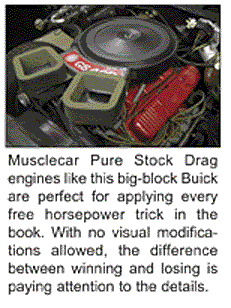
Virtually everyone is enamored with the major components in any engine build, and rightly so, that’s where the big power is. However, the difference between a winning engine and 2nd place is paying attention to all of the small details. The one common characteristic I’ve found in top engine builders and racers is that they leave no detail to chance.
Here are a few categories that we will discuss and how some minor tweaking can keep you out in front.
Friction – we hear a lot about reducing friction in internal combustion engines these days. There is a lot you can do if the rules allow.
Architecture – just because someone designed an engine a certain way, doesn’t mean you can’t make small changes that can make a big difference.
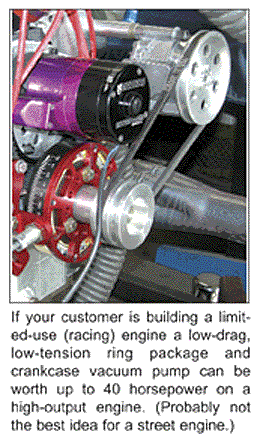
Choice of Components – The parts you install in your next buildup will have a direct affect on how well it runs. That’s obvious, but probably not for the reasons you are thinking.
Setup – Having all of the "right stuff" is pointless unless you know how to get the most out of it. (More on that in an upcoming "Performance Notes" column.)
Let’s begin with the most obvious horsepower drag – friction. There are a few types of friction that will sap away your horsepower. The most obvious is metal rubbing on metal. Another big friction source known as windage is where the spinning crankshaft and rods and pistons come into contact with that extremely viscous liquid, your engine’s oil. If you want to know what kind of forces we are talking about, just think about the amount of resistance water has when you try to splash your buddy in the swimming pool (and oil is much more viscous than water). To emphasize the importance of the windage issue even more, I went to a performance seminar put on by Chrysler’s Direct Connection in the early ’70s back in Detroit; it was put on by Tom Hoover, Dave Koffel, the late Dick Maxwell, and Larry Shepard plus a few other Chrysler engineers. Their credentials were "pretty good" like being the original Ramchargers and designing the 426 Hemi, just to name a couple. They also oversaw the Motown Missile that was the scourge of Pro Stock in those days. The seminar was a two-day affair and I was expecting to learn big news about the latest cylinder head developments or what’s new in camshafts. What did they talk about for the full two days? Oil pans, windage trays and crank scraper design. Man, was I disappointed – how boring! Little did I know the research that was behind this, and the true benefit to a racer if he heeded their advice!
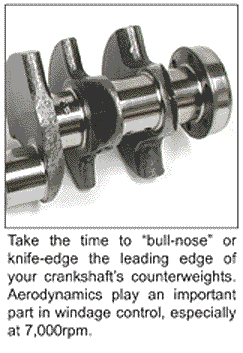
So let’s look at some of the things you should be incorporating into your customer’s wet-sump lubrication systems.
Use the deepest pan the chassis or rules permit. By using a plexiglass oil pan Chrysler found that the deeper the pan, the less splash back on the crank.
Use a crank scraper that literally shears oil off of the spinning crank and directs it back into the oil pan.
Install a full windage tray (the stock O.E. "shorties" help but don’t get the job done). The new one-way screen-type windage trays are better than the solid metal baffle type that can splash the oil right back into the path of the crank.
If legal, bull-nose or knife-edge the leading edge of your crank’s counterweights.
For those wanting every little horsepower, relieve the oil pan rail and use or build a "kick-out" pan that gives the oil an easier path to the pan sump. But remember, all of this work won’t mean a hoot unless you totally close off the oil return holes in the engine’s valley above the camshaft. The top-end oil should be directed to return at the very front, or the very rear of the block only.
Final consideration for your lubrication system should be to run the lowest pressure, high volume pump your engine requires to live. Most modern engines need flow, not pressure. There are exceptions, my big-block Buick needs 80-100 psi due to its huge main and rod journal diameters, but a small-block Ford might only need 25 psi. Next, run the lightest synthetic oil you can, and add a high-pressure additive like those available from Justice Brothers, Prolong, Lucas and many others.
Now that we have a handle on the windage issue lets see where else we can reduce a little metal-on-metal friction. The most popular method these days is to use low-drag piston rings and install a vacuum pump on the engine to help control oil contamination in the combustion chamber. This little trick is good for 40-50 horsepower on a race motor, but the vacuum pump, low-tension ring setup is not a good option for a "real" street engine. For real everyday street engines stay away from the low tension ring packages.
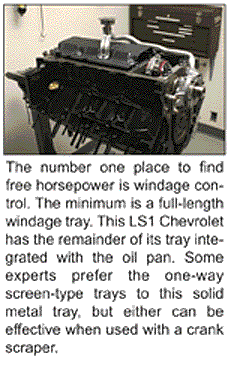
Another area to cut friction is to work with your custom piston manufacturer for shorter skirt pistons and pistons machined with different "cam" profiles. Obviously, you need enough skirt area to distribute the thrust loading on thin-wall blocks, but aftermarket blocks or those like the 400 cid Buick that can be bored .125" can use a more aggressive (less surface area) skirt.
Other friction reducing ideas include having an align-honed block and a straight crankshaft. I see lots of people getting their blocks align-honed but very few take time to check their cranks for straightness. Another area with a huge amount of friction is in the valvetrain. Reducing rocker scrub at the valve tip can really make a difference. What’s it take? Roller rockers with a roller tip and most importantly a
longer rocker pivot length (only available with a shaft rocker system). Dan Jesel of JESEL Valvetrain Innovation provided this tech tip. "In a typical small-block Chevy a longer pivot rocker arm can reduce the amount of force required to rotate a long block by as much as 80 ft. lbs. of torque." Also, Jesel claims it’s important to set up your valvetrain with the correct geometry where the rocker arc (and scrub) is greatest at low lifts and low spring pressures, and the rocker arc is very small during the last 30 percent of valve lift where spring pressures are highest.
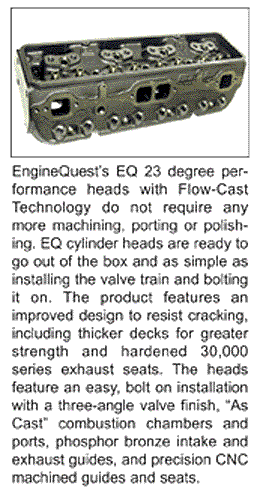
While we are on the valvetrain, here’s an easy one – run the stiffest pushrod you can find. If the rules require that you run a stock diameter pushrod like the popular OE 5/16"-diameter pushrods found in domestic V8s, select a thicker-wall aftermarket chromemoly pushrod. Why? Stock Eliminator racers have found up to a 30 hp increase by just changing pushrods and that’s with stock spec valvesprings.
What about engine coatings? You hear a lot about them these days and although they don’t show big power increases (a recent test by Hot Rod Magazine produced just single digit horsepower increases), they do offer a measure of insurance in the event of momentary oil starvation or higher than normal water temps.
Messing with your engine’s architecture can add little bits of horsepower that can mean the difference between a winning and losing engine. Many of these are machining operations that can be a good profit center for any engine builder. Let’s look at the cylinder heads first. Just because the factory installed locating dowel pins in the block and heads doesn’t mean that’s where the heads belong for best power.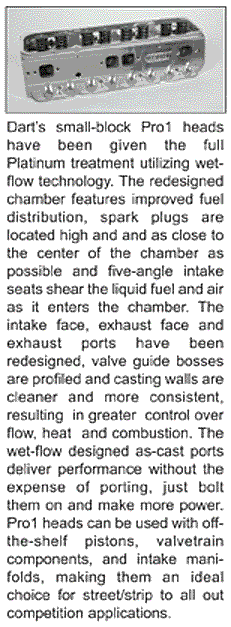
Doug Dye, a successful Econo dragster racer in the ’70s tipped us off to moving the heads on a big-block Chevy to shift the intake valve away from the cylinder wall. This won’t work on every engine, but if you are running big valves and a small bore, it can’t hurt to bolt a head on a bare block, flip it upside down and see if the head can be shifted on the block to unshroud the intake valve. Blue the deck surface and scribe the bore position on the heads and you can see how much you need to move the head. You may have to slightly enlarge the head boltholes to make the shift. Once you determine the optimum position you can reposition the dowel pins so the heads go back on the same way every time.
Another old cylinder head trick is to angle mill the heads instead of taking a straight cut off of the deck surface. What this does is essentially "flatten" the valve angle to a more advantageous angle like aftermarket heads now have. Also, when setting the engine’s compression ratio try to attain as small a clearance as possible in the quench area between the piston and cylinder head (just touching is perfect). Traditional wisdom is about .060" but that can vary depending upon connecting rod type and transmission type (missed shifts require a couple more "thou"). The point is to force every bit of burnable mixture into the center of the combustion chamber.
We talked a lot about crank prep in the windage discussion, but there’s more you can do here, depending upon how adventurous you are at pushing the rules. Most production cranks need to be reground for performance rebuilds so why not add a little stroke while you are at it? NHRA Super Stock champ Larry
Tores claims that offset grinding a crank for .015" of increased stroke is nearly undetectable in a field tech inspection (and he went through a lot of them) because of piston rock in the bore. Larry also gave us another tech tip that is worthwhile. Think your engine is clean and ready for assembly after you wash it with a brush and hot detergent before final assembly? No way! Before you slide those pistons in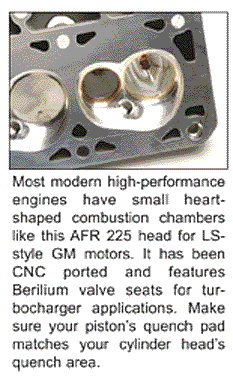
place take a paper towel and some ATF and start wiping the bores. That black stuff that comes off onto the towels is honing grit. Just keep wiping until you no longer see black residue on the paper towel. Otherwise, your engine will continue the honing (wear) operation when you start it up.
Still more crank stuff. This is higher end and reserved for aftermarket cranks, but reducing the rod journal size is now an option with the many custom aftermarket rods available. Take last year’s Jeg’s Engine Masters Challenge winner Tony Bischoff’s BES Racing’s 434 cid Ford Windsor. Tony reduced his 714-horsepower Ford’s rod journals to Honda-sized 1.888" and cut the counterweight diameter down adding lots of heavy metal to balance it. What he got was an extremely lightweight rod (approximately 500 grams) and a bunch less rotating drag. Reducing crank mass is an extremely important factor in engine acceleration and reducing the rod, piston and pin reciprocating weight is just as important. Stopping and accelerating the reciprocating mass 14,000 times per minute (7,000 rpm) requires a lot of energy your engine could otherwise be putting to the pavement.
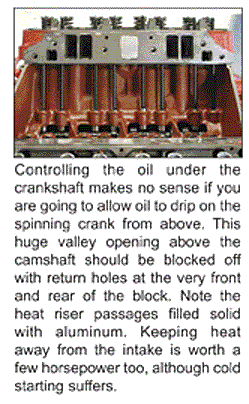
Like many competitors in the Jeg’s Engine Masters Challenge, Bischoff decided to use an "under square" engine combination – that is the stroke would exceed the bore size. It seems that the secret to making big power in the 2,500-6,500rpm range with pump gas is stroke, something we’ve been preaching for the last few issues of Engine Builder.
Although we’ve primarily discussed internal engine components, don’t forget about the bolt-on accessories – there’s hidden horsepower available there too. A couple of examples are "slabbed" throttle shafts for your carburetor along with a set of button-head screws to retain the throttle blades. These easy mods can be worth some power. If you have access to a dyno try moving the carb around on the manifold especially if it is the spreadbore type. Also try varying the throttle blade angle at full throttle to redirect the airflow into the manifold. There a few items designed to direct more air into the carburetor like K&N’s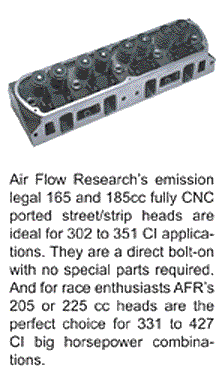
Stub Stacks that provide a smooth entry at the carb body and Professional Product’s AIRFLO air cleaner insert that helps turn the incoming air down into the carb. Also don’t forget about the clylinder heads. Most aftermarket cylinder head manufacturers offer lower cost "as cast" heads that bolt right on for an easy way to add power without doing a lot of extra machine work.
Underdrive pulleys for the alternator and water pump (use an electric water pump if you can), will also save you some power. More stealthy mods include a cutout switch to take the alternator off line and cutting down the water pump impeller for less drag.
A final thought – don’t try any one of these engine-building tips and expect huge results. The results come when you do them all, or at least all that you can legally do within the rules of your racing organization. Two and three horsepower here and there have a way of mounting up, and that’s what makes the difference between you being a mediocre engine builder and a winner that everyone wants to do business with!













